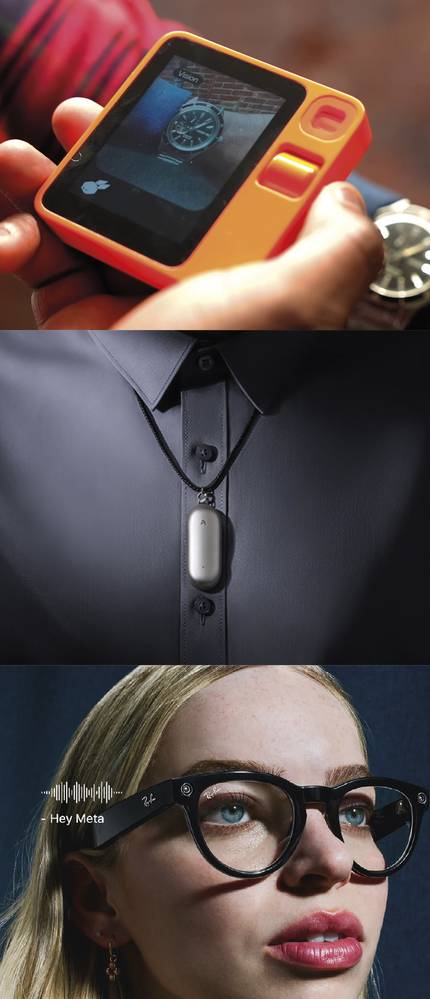New devices for the era of artificial intelligence
Thanks to the progress of artificial intelligence in recent years, electronic devices can do many more things and speech has gained strength in its interaction with them. Thus, beyond computers, phones and clocks, a wide variety of new types of devices are appearing on the market that offer and take advantage of these new opportunities. All of them have also been created with the intention of being a new apparatus that defines the new era, although for the moment none is having great success, but who knows if in the future any of them or more recent ones will succeed in prevailing... Let’s get acquainted with some of these essays.
Since the widespread and widespread use of electronic devices, the way we interact with them has not changed much. Their main supports or formats have been the computer and the mobile phone (and a little bit of the clock lately). And they’ve always outputted us through a screen and audio, while they used the keyboard and mouse on computers and mobile touchscreens and clocks to pick up the pulse. But now, thanks to the progress of Artificial Intelligence (hereinafter AI), computers have a higher level of understanding and are able to respond to more complex tasks, and they also process speech well, that is, they understand what they are called by speech and they themselves speak naturally. This has led to the creation of small computers that do not have screens, keyboards or anything like that, and the interaction with them is carried out through speech.
The unclassifiable Rabbit r1
Starting with a list of such devices, although it is not included among them in the strict sense, we cannot fail to mention the Rabbit r1 device. Although it has a screen –also touch-screen–, and it has most of the components and functionalities that a mobile phone can have, it can not even be classified among them: it is square, thick, it has a large wheel for the scroll, the button to start the conversation..., and it is designed to be used mainly by speech. Answer verbal questions by speaking, identifying objects in images, adapting photos, translating directly what has been said or the text photographed with the camera, transcribing meetings... all using AI. But while it attracted attention at first (perhaps, at least in large part, due to its strange and striking appearance), it received strong criticism for its performance. Maybe it was too early for something like this (it came out in early 2024), maybe the AA services you use didn’t work so well then and now it works better... but you haven’t heard much about it since.

The Pins
On devices without screens, perhaps the most popular are the pins. The first of these was the AI Pin of the company Humane, which was launched in November 2023. It was a small square device that was placed on the lapel, with a chatbot that answered questions asked by speech. In addition, projected at the user’s disposal, it could visualize the output, and it had a touchpad or touchpad for scrolling or screen changes on the pin itself, or the camera detected hand signs. It was a good concept and there was a lot of talk about it at first (there were former Apple employees behind it, it received investments from tech giants...), but it also came out too quickly because it didn’t seem to work very well, and it was cancelled in February of this year.
Other pins created later, however, continue and seem to be successful. But they are not so designed for interaction, but for audio recording: we can record a note, a conversation or a whole meeting at any time, and then we will have the transcription, translation, summary... on the computer. In addition to wearing it on the brooch, it also has accessories to wear as a bracelet or necklace. The most popular of these is the Plaud NotePin, but there are others such as Limitless or Bee.
The Counterattack of the Glasses
More than ten years ago, Google tried to revolutionize the landscape of portable electronic devices with Google Glass smart glasses. They had several sensors and a camera that could visualize information, instructions and so on through augmented reality on the crystals, and the command could be given to them through speech. But after a couple of years of experimentation and availability in some markets, they were abandoned. There were a number of technical reasons for this (such as battery life and size or the need to operate linked to a phone), but the main problem was privacy concerns: people were concerned that people wearing these glasses would not be recording conversations or video and broadcasting to the Internet (which were also said to be contests), there were also concerns about legality...
Well, now there are several other companies that are launching smart antiojos. Meta and Ray-Ban are said to have been quite successful together, probably because, as we’ve said, today’s speech knowledge works much better and the orders they can execute via AI or the requests they can respond to are much more. And they’re not as ugly and eye-catching as those Google Glasses, they almost look like normal glasses (they don’t project anything to the glasses, since they provide all the answers and information by speech, just for our ears). And it seems that now the Met will launch new models with Oakley and Prada, for sports fans and luxury lovers respectively. Apple wants to get away with it, Xiaomi wants to get away with it. However, the problem of loss of privacy remains unresolved; it has even worsened, as these glasses are more disguised, and with Meta behind...
The mysterious device of the creator of OpenAI and iPhone
The one that is generating the most expectation among the new devices is one that has not yet come out. In fact, one of the main agents that has brought about the AI revolution, the company OpenAI (creator of the tools ChatGPT, Whisper, DALL-E and Sora), wants everyone, everywhere and at all times, to use their own tools, and to do so, it wants to invent a new device that will take advantage of these tools, that will bring about a real revolution and that will be bought and worn by each and every one of the people. That is to say, it intends to provoke the revolution that the smartphone assumed at the time, taking its place.
And what better way to do it than to sign one of the inventors of the smartphone? Well, that's what you've done, hired Sir Jony Ive, and you've given him that assignment. Ive played an important role in the design of the iconic and successful Apple Watch, iMac, iPod, iPhone and iPad devices in collaboration with Steve Jobs. And now he's trying to invent a new device for the AA era. The way it works is also very reminiscent of the creation of the iPhone: Ive and the leader of OpenAI, Sam Altman (who has a charismatic or guru character similar to Jobsena in the technological world), are working hand in hand, in total secrecy... This does not guarantee anything, but the expectations generated are high. See if they will be fulfilled.
Buletina
Bidali zure helbide elektronikoa eta jaso asteroko buletina zure sarrera-ontzian











